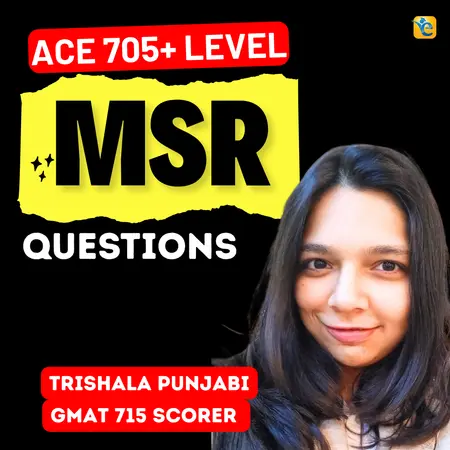Events & Promotions
|
|

GMAT Club Daily Prep
Thank you for using the timer - this advanced tool can estimate your performance and suggest more practice questions. We have subscribed you to Daily Prep Questions via email.
Customized
for You
Track
Your Progress
Practice
Pays
Not interested in getting valuable practice questions and articles delivered to your email? No problem, unsubscribe here.
- Nov 18
11:00 AM PST
-12:00 PM PST
Join us in a live GMAT practice session and solve 30 challenging GMAT questions with other test takers in timed conditions, covering GMAT Quant, Data Sufficiency, Data Insights, Reading Comprehension, and Critical Reasoning questions. - Nov 22
11:00 AM IST
-01:00 PM IST
Do RC/MSR passages scare you? e-GMAT is conducting a masterclass to help you learn – Learn effective reading strategies Tackle difficult RC & MSR with confidence Excel in timed test environment - Nov 23
11:00 AM IST
-01:00 PM IST
Attend this free GMAT Algebra Webinar and learn how to master the most challenging Inequalities and Absolute Value problems with ease. - Nov 25
10:00 AM EST
-11:00 AM EST
Prefer video-based learning? The Target Test Prep OnDemand course is a one-of-a-kind video masterclass featuring 400 hours of lecture-style teaching by Scott Woodbury-Stewart, founder of Target Test Prep and one of the most accomplished GMAT instructors.
Originally posted by Nanobotstv on 10 Jun 2018, 16:23.
Last edited by Sajjad1994 on 16 Oct 2023, 03:27, edited 8 times in total.
Last edited by Sajjad1994 on 16 Oct 2023, 03:27, edited 8 times in total.
Kudos
Bookmarks
Dropdown 1: 4,000 and 5,000
Dropdown 2: 3 times
Be sure to select an answer first to save it in the Error Log before revealing the correct answer (OA)!
Difficulty:
 95%
(hard)
95%
(hard)
Question Stats:
43% (02:46) correct 57%
(02:45)
wrong
57%
(02:45)
wrong  based on 1337
sessions
based on 1337
sessions
History
Date
Time
Result
Not Attempted Yet
The graph models the hypothetical mass, in kilograms, of a Tyrannosaurus rex up to 30 years of age. Points A, B, and C represent the masses for a Tyrannosaurus rex at ages 12,16, and 20, respectively, according to the model.
From each drop-down menu, select the option that creates the most accurate statement based on the information provided.
For integer values of the age from 12 to 30, the average (arithmetic mean) mass falls approximately between kilograms.
The percent change in the mass from age 12 to age 16 is approximately the percent change in the mass from age 16 to age 20.
Attachment:
t-rex.jpg [ 47.6 KiB | Viewed 32245 times ]
ShowHide Answer
Official Answer
Dropdown 1: 4,000 and 5,000
Dropdown 2: 3 times
Kudos
Bookmarks
1)C,since most of mass in the age range of 16-30 lies between 3000-5500 while 12-16 lies between 900-3000 so we can see here the major portion of the age interval is in 3000-5500 portion so the average will be between 4000-5000
2)% change from 12 to 16 is 3000-900/900 * 100 =233%
While from 16 to 20 it is 5100-3000/3000 * 100= 70%,
So change from 12 to 16 = 3*change from 16 to 20
Posted from my mobile device
2)% change from 12 to 16 is 3000-900/900 * 100 =233%
While from 16 to 20 it is 5100-3000/3000 * 100= 70%,
So change from 12 to 16 = 3*change from 16 to 20
Posted from my mobile device
Kudos
Bookmarks
SajjadAhmad
1-) Assume the change, with a mean of 3000, is linear from the age of 12 to the age of 20. Assume the change is constant at 5500 from the age of 20 to 30.
Calculate the average;
(3000*8+5500*10)/18=4389. Accordingly, C is the answer.
2-) Mass at 12, 1 ton, Mass at 16, 3 tons, Mass at 20, 5 tons
Percent change from the age of 12 to the age of 16 is ((3-1)/1)*100=300
Percent change from the age of 16 to the age of 20 is ((5-3)/3)*100=200/3
Accordingly, the answer is C.














